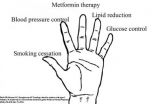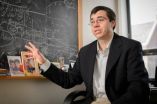(Press-News.org) Scottsdale, Ariz., February 20, 2014—Evaluating next-generation sequencing (NGS) data and associated clinical records of head and neck squamous cell carcinoma (HNSCC) patients from several institutions, made available through The Cancer Genome Atlas (TCGA), showed that combining Mutant-Allele Tumor Heterogeneity (MATH) as a biomarker with the patient's HPV status provides an effective indicator of improved patient outcome, according to research presented today at the 2014 Multidisciplinary Head and Neck Cancer Symposium.
The TCGA data available for HNSCC patients included 302 patients, with 35 HPV-positive patients. The researchers' examination confirmed that high tumor MATH at time of surgery is an indicator of poor outcome (high-MATH hazard ratio (HR) = 2.1; 95 percent confidence interval (CI), 1.4 to 3.2; p = 0.0002, logrank test) and that HPV-positive HNSCC patients have lower average MATH values than HPV-negative HNSCC patients. In bivariate analysis, both MATH and HPV were significantly associated with survival. When stratified by HPV status, MATH was similarly related to outcome in clinically defined subsets of patients regardless of clinical characteristics (tumor margins, nodal classification or tumor staging). Median follow-up with the 173 surviving patients was 22 months.
A tumor can contain many different types of cancer cells. Standard DNA sequencing discovers both the DNA mutations that differ among cancer cells and gives a measure of diversity. Genetic heterogeneity of each tumor was assessed by MATH, the percentage ratio of the width to the center of the distribution of tumor-specific mutant-allele fractions. In order to compare to previous studies, analysis was limited to mutant-allele fractions no less than 0.075, and the high-MATH cutoff value of 32, previously found to distinguish outcome classes, was used. Cox proportional hazards analysis was used to evaluate the relations of MATH and HPV to overall survival.
"Calculating patients' MATH marker as well as their HPV status is a more reliable predictor of patient survival, and the methodology that we used to measure MATH is simple enough that it could be adopted readily in the clinic,"said author James Rocco, MD, PhD, a head and neck surgical oncologist at Massachusetts General Hospital and Massachusetts Eye and Ear Infirmary, and the Daniel Miller Chair in Otology and Laryngology at Harvard Medical School in Boston. "Now that we know that both HPV status and intra-tumor heterogeneity matter for patient outcome, we are in a better position to personalize therapy for our patients. We can try less toxic therapies in patients likely to be cured, and try new or alternate therapies in patients likely to fail. In addition, it may help identify the patients most likely to benefit from clinical trials."
INFORMATION:
The abstract, "Mutant-Allele Tumor Heterogeneity (MATH) Adds to Human Papillomavirus (HPV) Status in Predicting Outcome in Head and Neck Squamous Cell Carcinoma (HNSCC)," will be presented in detail during a scientific session at 10:30 a.m. Mountain time on Friday, February 21, 2014, at the 2014 Multidisciplinary Head and Neck Cancer Symposium. To speak with Dr. Rocco, contact Michelle Kirkwood on February 20 – 21, 2014 in the ASTRO Press Office at the JW Marriott Camelback Inn Resort and Spa in Scottsdale, Ariz., at 480-596-7085 or email michellek@astro.org.
The 2014 Multidisciplinary Head and Neck Cancer Symposium is sponsored by the American Society for Radiation Oncology (ASTRO), the American Society of Clinical Oncology (ASCO) and the American Head & Neck Society (AHNS). The two-and-a-half day meeting includes interactive educational sessions focused on topics such as supportive care, directed therapy, new surgical and radiotherapeutic techniques, as well as 12 oral abstract presentations of the current science of relevance to the head and neck cancer community. A total of 189 abstracts will be presented including 177 posters. Keynote speakers include Jennifer Grandis, MD, of the University of Pittsburgh, to present "The Molecular Road to Defining and Targeting High-risk Head and Neck Patients;" and Julia H. Rowland, PhD, of the National Cancer Institute, to present "Cancer Survivorship: Research Opportunities on the Path to Where We Want to Be."
Embargoed until 8:00 a.m. MT, February 20, 2014
2014 Multidisciplinary Head and Neck Cancer Symposium
News Briefing, Thursday, February 20, 2014, 7:00 a.m. Mountain time
Scientific Session: Friday, February 21, 2014, 10:30 a.m. Mountain time, Arizona Ballroom A-G, JW Marriott Camelback Inn Resort and Spa
7 Mutant-Allele Tumor Heterogeneity (MATH) Adds to Human Papillomavirus (HPV) Status in Predicting Outcome in Head and Neck Squamous Cell Carcinoma (HNSCC)
J. W. Rocco1,2, A. D. Tward2,3, Y. Ren4, R. J. Hammon2, E. A. Mroz1, 1Massachusetts General Hospital, Boston, MA, 2Massachusetts Eye and Ear Infirmary and Harvard Medical School, Boston, MA, 3The Broad Institute of MIT and Harvard, Cambridge, MA, 4Harvard Medical School, Boston, MA
Background: Next-generation sequencing (NGS) data and associated clinical data made available by multiple institutions through The Cancer Genome Atlas (TCGA) provide opportunities for testing clinical hypotheses in HNSCC. Based on 74 cases from a single institution, we had previously shown that a measure of intratumor genetic heterogeneity derived from NGS data, MATH, is related to outcome in HNSCC (Oral Oncology 49: 211, 2013; Cancer 119: 3034, 2013). Only a limited number of HPV-positive cases were available for that initial study. We sought to determine, in the larger TCGA HNSCC dataset with over 300 cases, whether the MATH biomarker of intratumor genetic heterogeneity improves HNSCC outcome prediction based on HPV status.
Methods and Materials: We examined exome NGS data and associated clinical data on HNSCC available from TCGA. Genetic heterogeneity of each tumor was assessed by MATH, the percentage ratio of the width to the center of the distribution of tumor-specific mutant-allele fractions. For comparison with previous work, we limited analysis to mutant-allele fractions no less than 0.075 and used the high-MATH cutoff value of 32 previously found to distinguish outcome classes. Cox proportional hazards analysis was used to evaluate the relations of MATH and HPV to overall survival. Both clinical and NGS data were available for 302 patients, 35 with tumors positive for HPV. Median follow-up of the 173 surviving patients was 22 months.
Results: We verified that high tumor MATH at time of surgery is a poor prognostic sign (high-MATH hazard ratio, HR, 2.1; 95% CI, 1.4 to 3.2; p = 0.0002, logrank test) and that HPV-positive HNSCC have lower average MATH values than HPV-negative HNSCC (34.2 ± 2.3 SEM vs. 39.8 ± 0.7; p = 0.007). In bivariate analysis both MATH and HPV were significantly associated with survival (high-MATH HR, 1.8; 95% CI, 1.2 to 2.8; HPV-positive HR, 0.36; 95% CI, 0.18 to 0.75; p = 0.0002, logrank test). In analyses stratified by HPV status, MATH was similarly related to outcome in clinically defined subsets of patients, whether the patient subsets had favorable or unfavorable clinical characteristics (negative tumor margins: high-MATH HR, 2.2; nodal classification N0: high-MATH HR, 2.0; AJCC Stage III-IV: high-MATH HR, 1.7).
Conclusions: In the multi-institutional HNSCC data set provided by TCGA, including MATH as a biomarker of intratumor heterogeneity improved outcome prognostication based on HPV status. These results support the evaluation of MATH as a prognostic biomarker to be added to HPV status in the design of clinical trials and, ultimately, in treatment choices.
Author Disclosure Block: J.W. Rocco: None. A.D. Tward: None. Y. Ren: None. R.J. Hammon: None. E.A. Mroz: None.
MATH, HPV status in HNSCC patients effective markers of improved patient outcome
2014-02-20
ELSE PRESS RELEASES FROM THIS DATE:
Rural primary care physicians are committed to professionalism, quality improvement
2014-02-20
The increased demand for primary care services expected to result from the Affordable Care Act (ACA) may be felt strongly in rural areas. While studies have found that the quality of care delivered to rural patients is as good or better than that available in urban areas, the belief persists that top-quality primary care is only available in big cities. But a new study appearing in the National Rural Health Association's Journal of Rural Health finds few meaningful differences between rural and urban primary care physicians on key measures of professionalism, including ...
Study examines correctional officer stress
2014-02-20
HUNTSVILLE, TX (2/20/14) -- Conflicts between work and family life were the most significant issues that affect work stress and job satisfaction among correctional officers, a new study by the Correctional Management Institute of Texas at Sam Houston State University found.
In a study of 441 correctional officers from adult prisons in the South, the most significant work-home issues experienced by correctional officers were demands and tensions from work that impact their home life; an incompatibility between the officer's role at work and at home; and family circumstances ...
Meet your match: Using algorithms to spark collaboration between scientists
2014-02-20
Speed dating, in which potential lovers size each other up in brief 10 minute encounters before moving on to the next person, can be an awkward and time-wasting affair. Finding the perfect research partnership is often just as tough. Speed dating-style techniques are increasingly used at academics conferences, but can be equally frustrating - with busy academics being pushed into too many pointless encounters.
But now a group of scientists led by geneticist Rafael Carazo Salas have constructed a system that could revolutionise conference speed dating - by treating scientists ...
Editorial illustrates shift away from glycemic control in diabetes treatment
2014-02-20
BOSTON (February 20, 2014)—An editorial in a February issue of American Family Physician proposes a simple way for physicians to communicate with patients about the best treatments for diabetes. The "lending a hand" illustration reprioritizes treatment goals, based on research on mortality reduction, to convey that glycemic control is no longer the primary intervention.
In order of benefit, to improve length and quality of life, patients with type 2 diabetes benefit from these interventions, starting with smoking cessation:
"Glycemic control is stuck in people's minds ...
Why are some children more resilient to post-traumatic stress?
2014-02-20
New Rochelle, NY, February 20, 2014—Children exhibit a range of responses to traumatic events such as natural disasters, with some suffering acute traumatic reactions that resolve over time and others experiencing long-term symptoms of post-traumatic stress. Identifying factors that may help predict which youths are at greater risk of more serious disorders and which are likely to be more resilient following a traumatic event can help determine the care and services needed, according to an article in Journal of Child and Adolescent Psychopharmacology (JCAP), a peer-reviewed ...
What is El Nino Taimasa?
2014-02-20
During very strong El Niño events, sea level drops abruptly in the tropical western Pacific and tides remain below normal for up to a year in the South Pacific, especially around Samoa. The Samoans call the wet stench of coral die-offs arising from the low sea levels "taimasa" (pronounced [kai' ma'sa]). Studying the climate effects of this particular variation of El Niño and how it may change in the future is a team of scientists at the International Pacific Research Center, University of Hawai'i at Mānoa and at the University of New South Wales, Australia.
Two El ...
Remote Antarctic telescope reveals gas cloud where stars are born
2014-02-20
Using a telescope installed at the driest place on earth - Ridge A in Antarctica – a UNSW-led team of researchers has identified a giant gas cloud which appears to be in an early stage of formation.
Giant clouds of molecular gas – the most massive objects in our galaxy – are the birthplaces of stars.
"This newly discovered gas cloud is shaped like a very long filament, about 200 light years in extent and ten light years across, with a mass about 50,000 times that of our sun," says team leader, Professor Michael Burton, an astronomer at UNSW Australia.
"The evidence suggests ...
With friends like these, who needs democracy?
2014-02-20
EAST LANSING, Mich. — From Ethiopia to Nicaragua, countries that go through civil war are much less likely to become democratic if the winning side gets help from rival nations, a Michigan State University political scientist argues.
In a new study examining democratization after civil wars since World War II, Michael Colaresi found the majority of groups that eventually took power failed to establish democratic governments if those groups took money or weapons from a foreign enemy during the war.
Receiving such aid can create mistrust among the nation's citizens and ...
Sustainable use of energy wood resources shows potential in North-West Russia
2014-02-20
Nowadays, humanity faces many challenges; the most serious are poverty, the growing demand for resources and the deterioration of the environment. In order to satisfy the growing demand for wood, forestry in many countries has to be intensified. The forests of the Russian Federation are the world's largest reserve of wood for different purposes. Intensification of forestry in Russia will result in increasing availability of wood for material and energy uses.
A doctoral dissertation completed at the University of Eastern Finland analysed the potential of energy wood resources ...
From a distance: New technique for repair work
2014-02-20
This news release is available in German.
Numerous German companies are operating globally these days: They develop products domestically, but production is done in other countries like China, Brazil or the Czech Republic. If maintenance or repair work is needed, the engineers who had designed the complex production plants frequently have to travel from Germany.
A novel approach by computer scientists in the research group of professor Thorsten Herfet from the Chair of Telecommunications at Saarland University could provide a solution: a platform that brings together ...





